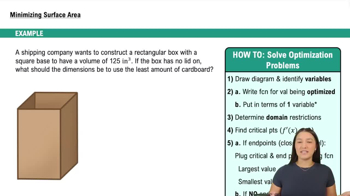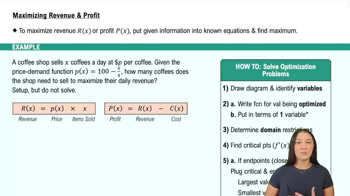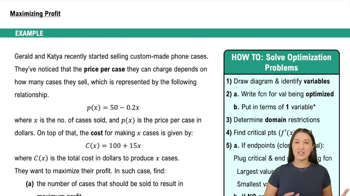Table of contents
- 0. Functions7h 52m
- Introduction to Functions16m
- Piecewise Functions10m
- Properties of Functions9m
- Common Functions1h 8m
- Transformations5m
- Combining Functions27m
- Exponent rules32m
- Exponential Functions28m
- Logarithmic Functions24m
- Properties of Logarithms34m
- Exponential & Logarithmic Equations35m
- Introduction to Trigonometric Functions38m
- Graphs of Trigonometric Functions44m
- Trigonometric Identities47m
- Inverse Trigonometric Functions48m
- 1. Limits and Continuity2h 2m
- 2. Intro to Derivatives1h 33m
- 3. Techniques of Differentiation3h 18m
- 4. Applications of Derivatives2h 38m
- 5. Graphical Applications of Derivatives6h 2m
- 6. Derivatives of Inverse, Exponential, & Logarithmic Functions2h 37m
- 7. Antiderivatives & Indefinite Integrals1h 26m
- 8. Definite Integrals3h 25m
5. Graphical Applications of Derivatives
Applied Optimization
Problem 4.5.30
Textbook Question
Shortest ladder A 10-ft-tall fence runs parallel to the wall of a house at a distance of 4 ft. Find the length of the shortest ladder that extends from the ground to the house without touching the fence. Assume the vertical wall of the house and the horizontal ground have infinite extent.
 Verified step by step guidance
Verified step by step guidance1
Visualize the problem by sketching the scenario: draw the house wall, the fence, and the ground, marking the distances involved (4 ft from the wall to the fence and the height of the fence at 10 ft).
Define the variables: let 'L' be the length of the ladder, 'x' be the horizontal distance from the base of the ladder to the wall of the house, and 'y' be the height at which the ladder touches the wall.
Use the Pythagorean theorem to express the length of the ladder in terms of 'x' and 'y': L = √(x² + y²).
Set up a relationship between 'x' and 'y' using similar triangles, considering the triangle formed by the ladder, the wall, and the ground, and the triangle formed by the fence and the ground.
Minimize the length 'L' by taking the derivative of the expression obtained in step 3 with respect to 'x', setting it to zero to find critical points, and determining the minimum length of the ladder.
Was this helpful?

 1:13m
1:13mWatch next
Master Intro to Applied Optimization: Maximizing Area with a bite sized video explanation from Callie
Start learningRelated Videos
Related Practice









